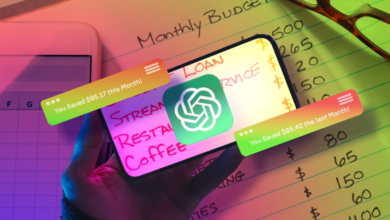4 Key Money Moves for College Grads

When I graduated college last spring, I was excited to start working and thrilled to start making money. I also had no idea how to manage the money I earned. Over the past few months, I’ve learned a lot—including some things that could make any graduate’s first year a lot easier.
For those of us born in the early 2000s, the transition to “adulting”—that term Gen X despises and Gen Z fears—hasn’t been easy. Covid upended much of our time in college, and we graduated into rapid inflation as part of an economy many Americans still aren’t happy with. That has made typical milestones like moving out and buying a car harder than ever. Fortunately, I found taking charge of your finances when you’re young isn’t as hard as I thought.
I definitely have some advantages: Unlike more than half of college grads (according to a College Board study from 2022), I don’t have student loans to pay off, and like many recent grads, I moved back home after graduation. Lucky for me, that means living in New York City. (Unluckily, it means sharing a room with my little sister.) Despite that leg-up, I still need money for fitness classes and theater tickets, and I can’t live with my parents forever, so budgeting and saving are still top priorities right now.
I majored in English (which is a useful degree, despite what relatives might tell you) and was never educated on personal finances, so I feel lucky that I sit next to the Buy Side personal finance editors who answered my money questions. Here are the four money moves I learned from them that all recent grads should know about.
Make a budget
Even without rent, I’m still working an entry-level job in one of the world’s most expensive cities—Broadway shows, happy hours and midtown lunches add up. I have no regrets about seeing “Merrily We Roll Along” three times and taking Amtrak to visit my college friends in Philly, but I quickly realized I need to get a handle on my finances.
Since I have a Chase credit card (more on that later), I started by using the budgeting feature in the Chase app. Because it’s automatically connected to my card, it always knows just how much money I have in my Chase checking account and where I spend the most with my card.
I set my total monthly budget to be half my monthly income so I can save the other half. Then I broke that budget into five categories: food and drink; shopping; travel; entertainment; and health and wellness.
It took me a couple months to adjust the numbers so the spending limits felt reasonable. (And to account for items like a new laptop, since I’d had my old one since high school.) But once I finagled the numbers, it was easy to see how much I could spend on the things I need and care about—and where I should cut back.
Don’t use Chase? There are lots of helpful budgeting apps out there. Monarch Money, Buy Side’s top pick, is easy to use and boasts plenty of smartly designed features. Some are even free.
Open a savings account
Of course, once I got my budget under control, I realized putting money aside is just half the battle. I needed to rethink where I kept my money so I could grow what I saved. The effort has already paid off—last month I earned $70 just for letting my money sit there.
The first thing to know: Not all bank accounts are created equal. In college I had a checking account that paid no interest. After I started working, I switched to a savings account. While savings accounts are a bit less convenient (many require you to keep a minimum balance and limit your withdrawals), they can pay interest northward of 4%.
I went with a Capital One 360 performance savings account—recommended by both my best friend and my colleagues at Buy Side. It has an APY, or interest rate, of 4.35%, no minimum balance or monthly maintenance fee and a convenient web and mobile app, all features I like.
If you’re looking for help getting organized, the Ally Online Savings account is another great option and Buy Side’s pick for best online bank. It offers a digital version of the “envelope” or “bucket” system, allowing you to break your savings into up to 10 different buckets, earmarked for particular expenses, like an emergency fund or trip.
Get a credit card
After all that talk about saving money, it’s finally time for the fun part—spending it.
Like most other students I know, I got through college with a debit card, which I mostly used for school supplies, food and lots of chai lattes. While credit cards require some extra discipline—don’t be tempted to spend money you don’t have—they come with lots of extra benefits, including not carrying around lots of cash in a big city.
First, credit cards are safer than debit cards, because they help protect you against fraud; you can always call your credit card issuer to dispute false charges, and you may even be contacted if they notice suspicious transactions on your card.
Second, paying your credit card on time can build credit, which can help you out when it’s time to apply for a car or home loan, get approved for higher credit limits and even pass background checks from potential employers.
But the most exciting part of switching to a credit card is the rewards. I got the Chase Freedom Unlimited card, which has no annual fee, and gave me $200 back just from spending $500 in the first three months (a goal that I hit quite a bit earlier than the deadline). I also get 3% cash back on dining, which is where I spend the most, and 1.5% cash back on everything else.
If your focus is on building credit, Buy Side suggests trying the Discover it Secured card, which gets you double cash back in your first year. If you spend the most on dining and groceries, you can get 3% cash back on those purchases with the Capital One SavorOne Cash Rewards card.
Open a retirement account
For someone just out of college, retirement seems like half a lifetime away (because it is). But that doesn’t mean you can’t start saving while you’re young—in fact, it can make the job a lot easier down the road. Each dollar you invest at age 20 will grow to nearly $6 by the time you turn 65, according to a study based on historical investment returns by fund company Vanguard. If you wait until age 30, that dollar will turn into just $4—by 45 it’s down to $2.20.
If you’re lucky, your employer offers a 401(k) retirement account for you and may even match a percentage of the money you put in. I am not eligible for a 401(k) yet, so I opened a Roth IRA. A Roth offers similar tax benefits but works slightly differently. With a 401(k), the money you put in grows tax-free until retirement, while with a Roth IRA, you put in after-tax dollars, then withdraw it tax free.
A Roth IRA is also a good way to ease into investing. You can customize your account to be invested in stocks, bonds, CDs and more, or you can put it in a market-tracking index fund (which is what I did).
One other perk of a Roth IRA: You can withdraw your contributions (although not your earnings) whenever you want. That means it can also double as an emergency fund or seed a down payment down the road.
Got a money question? Let Buy Side find the answer. Email [email protected].
Include your full name and location, and we may publish your response.
Read More


